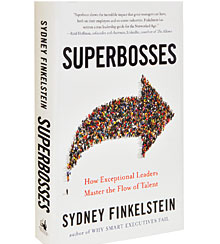How to Become a Talent Magnet
Superbosses examines the talent practices of those rare leaders whose protégés go on to dominate industries.
A version of this article appeared in the Autumn 2016 issue of strategy+business.
A decade or so ago, Sydney Finkelstein discovered an interesting fact about Alice Waters, the legendary chef at Chez Panisse in Berkeley, Calif., who played a pivotal role in launching the farm-to-table movement. “Industry insiders will tell you that Waters is also known for something else: spawning the country’s best culinary talent,” explains Finkelstein, Steven Roth Professor of Management at the Tuck School of Business at Dartmouth University. A host of James Beard Award winners — including the late Judy Rodgers of Zuni Café, California cuisine originator Jeremiah Tower, and chef and consultant Joyce Goldstein — worked for Waters early in their careers.
Intrigued at the outsized effect Waters has had on the top talent in her industry, Finkelstein wondered if there were leaders who had played a similar role in other sectors. He found them in fashion (Ralph Lauren), finance (hedge fund magnate Julian Robertson), professional football (San Francisco 49ers coach Bill Walsh), media (Philadelphia Inquirer editor Gene Roberts), politics (Hillary Clinton), and technology (Oracle founder Larry Ellison), to name a handful. And he’s written Superbosses: How Exceptional Leaders Master the Flow of Talent (Portfolio Penguin, 2016), an intriguing and insightful book, about them.
Even though superbosses can have wildly varying leadership styles, they conform to a recognizable pattern in their approach to people management, writes Finkelstein: They “identify, motivate, coach, and leverage others [in ways that] are remarkably consistent, highly unconventional, and unmistakably powerful.”
The first thing they do is hire the right people. Finkelstein writes that superbosses go above and beyond the best hiring practices to find people who “get it.” They look for exceptionally smart, creative, and flexible people. They find them by taking an active hand in hiring — grabbing good people when the opportunity presents itself, spending time with candidates, conducting unusual interviews, and taking chances on promising people with unorthodox backgrounds. The first chef Alice Waters hired for Chez Panisse was a graduate student in philosophy with no culinary experience; Bill Walsh hired a high school coach for his NFL staff. Sure, superbosses take some hiring risks, but when such a risk doesn’t pay off, Finkelstein tells us, they are quick to fire.
Next, those people are put to work. Superbosses expect perfection — and when they get it from someone, they pile on more challenges. Anneke Seley started working for Larry Ellison as receptionist and went on to manage customer relations and launch Oracle’s inside sales department. Though superbosses give employees lots of responsibility, they also make sure their people have a clear, compelling vision to guide them, and they provide plenty of frank feedback. Superbosses are unusually accessible, often working side by side with employees as a master would with an apprentice — Ellison himself taught Seley the SQL programming language. And they build teams of talented people — cultlike cohorts of high performers who support one another and drive results.
The superboss approach is powerful because it creates a virtuous circle. If you’re a superboss, you hire the best people and empower them to do their best work. Some percentage of these people flourish under your tutelage and become successes in their own right. You gain a reputation for launching great careers, and the best and the brightest want to work for you. You become a talent magnet. Given the careers that superboss Lorne Michaels of Saturday Night Live has had a hand in launching — from Eddie Murphy to Tina Fey — is it any surprise that he has his pick of comedic talent?
Another result of the superboss approach, to which Finkelstein devotes a chapter, is the network effect that is created by following the superboss playbook over the long term. If you are a superboss, many of the talented people you develop and nurture are going to move on. They are going to start their own businesses; they are going to be offered great jobs in other companies. If you maintain close, supportive relationships with these people after they leave, they become valued members of your professional network. They become suppliers and customers. They refer new talent to you. They also provide you with investment opportunities. Witness how, after closing Tiger Management, Julian Robertson provided the seed money that enabled some of his most talented managers to start their own hedge funds; in 2015, reports Finkelstein, Robertson’s so-called Tiger Seeds were managing US$32 billion in assets. Being a superboss pays dividends long after your protégés outgrow you.
Now, any endorsement of Superbosses — and I certainly endorse it for its enthusiastic advocacy of a hands-on approach to talent by top leaders — should include a couple of provisos. First, we need to recognize that Finkelstein’s contention that superbosses outperform other bosses is supported by anecdotal evidence only. Second, there’s no telling how much of the success that the leaders featured in the book have enjoyed is attributable to their distinct approach to talent. Third, we need to acknowledge that being a superboss is not all there is to being a boss. Almost a half century ago, Peter Drucker wrote that leaders had three principal tasks: to achieve the purpose and mission of the organization; to make work and workers productive; and to manage the organization’s social impacts and responsibilities. A winning way with talent is not all that's needed to successfully undertake these tasks.
The superboss approach creates a virtuous spiral. You become a talent magnet.
These reservations aside, there is no question that this is an era when talent is increasingly essential to the success of organizations. That alone makes Superbosses a useful and profitable addition to your leadership library.





